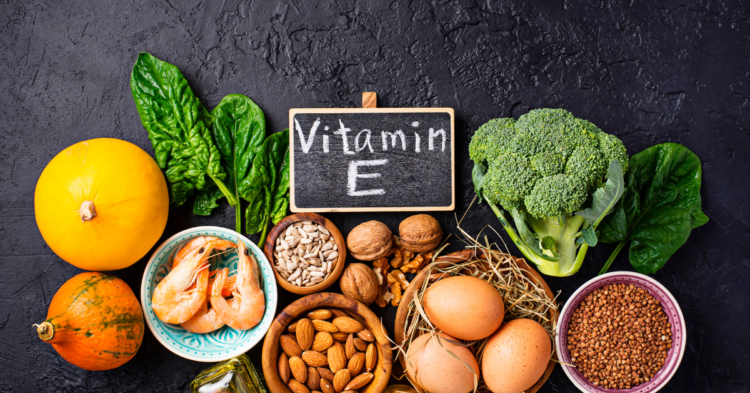Table of Contents
About Vitamin E
Vitamin E is the collective term for a family of eight chemically related substances: four tocopherols (alpha, beta, gamma, delta) and four tocotrienols (alpha, beta, gamma and delta.) Only Alpha tocopherol is maintained in human blood, but Gamma tocopherol is the main form of Vitamin E found in the diet. The body must somehow convert the gamma form to the alpha form is my guess.
There are some studies that say you can overdose on Vitamin E supplements because it is a fat soluble vitamin like vitamins A, D and K (Fat soluble vitamins are stored and build up in the liver.) It’s kind of hard to overdose with whole foods, however. This is one reason why I like working with specific foods and Standard Process products as they are whole food based supplements. Cataplex E is the Standard Process Vitamin E. It’s very safe and very bioavailable.
The other problem we are having with Vitamin E supplements these days is that the synthetic form (d, l, alpha tocophorol) has petrochemicals in it. You DO NOT want this form. There are lots of people out there with petrochemical allergies and they don’t even know it.
Signs of petrochemical allergies include:
- Getting the munchies when you are in the car.
- Falling asleep at the wheel.
- The smell of diesel nauseates you.
Also, cheaper forms of Vitamin E have a gel covering that contains Tartaric Acid which Blood Type O people seem to be allergic to quite often. So, look for the dl tocophorol form, mixed tocophorols, or whole-food based Vitamin E supplements. Stay away from the dl alpha form (like Costco brand, Puritan’s Pride, and cheap sale brands of Vitamin E.)
Signs of Vitamin E Deficiency:
- Anemia
- Breaking of red blood cells, leading to anemia (hemolytic anemia)
- Fat malabsorption syndromes, such as celiac disease, cystic fibrosis, and post-gastrectomy syndrome
- Hereditary disorders of red blood cells, such as sickle cell disease and thalassemia
- Involuntary movement of the eyes
- Muscle and nerve degeneration
- Muscle weakness
- Premature infants
- Poor coordination
Health Concerns Vitamin E is used for:
- Allergy
- Angina
- Arrhythmias
- Atherosclerosis
- Autoimmune disorders
- Cancer
- Cardiomyopathy
- Cataract
- Cervical dysplasia
- Diabetes
- Dysmenorrhea
- Epilepsy
- Gallstones
- Hepatitis
- Herpes simplex & zoster
- Immunosuppression
- Infections
- Inflammation
- Intermittent claudication
- Muscular degeneration
- Myopathy
- Neuralgia
- Neuromuscular degeneration
- Osteoarthritis
- Peptic ulcers
- Periodontal disease
- Peripheral vascular disease
- Pregnancy
- Scleroderma
- Ulcerative colitis
What Vitamin E Does:
- Accelerates healing, particularly of burns
- Acts as a natural diuretic
- Alleviates fatigue
- Antioxidant and helps slow down the process of aging
- Beneficial in the treatment of diabetes
- Boosts immunity
- Good in the treatment of ulcerative colitis
- Good in the treatment of Raynaud’s disease
- Helpful in treating fibrocystic breast disease
- Helpful in treating lupus
- Helpful in treating skin diseases (i.e. seborrheic dermatitis, skin ulcers)
- Helps accelerate wound healing
- Helps prevent miscarriage
- Improves the symptoms of Tardive dyskinesia
- Improves oxygen utilization
- Prevention of cataracts caused by free radical damage
- Prevents formation of thickened scars
- Protects against cardiovascular disease
- Protects against damage to the cell membranes
- Protects against heavy metals (i.e. lead, mercury)
- Protects against toxic compounds (i.e. benzene, carbon tetrachloride, and cleaning solvents; drugs; radiation; and the body’s free-radical metabolites)
- Protects against neurological disorders
- Protects the thymus gland
- Reduces the various symptoms of PMS and menopause
- Treats skin problems and baldness
- Useful in the treatment of multiple sclerosis
- Useful in the treatment of Parkinson’s disease
- Useful in treating Rheumatoid arthritis
FOOD SOURCES of Vitamin E:
- Almonds
- Asparagus
- Avocados
- Berries
- Broccoli
- Eggs
- Leafy greens
- Nuts
- Organ meats
- Peanuts
- Seeds
- Soy products
- Tomatoes
- Vegetable oils
- Vegetables
- Wheat germ (oil or fresh)
- Whole grains
Other Sources of Vitamin E–Brand Names:
- Dry E is a form of Vitamin E in veggie caps or gelatin capsules that does not have Tartaric Acid or a soft gel covering that is much safer for Blood Type O people to take.
- Cataplex E (Standard Process Labs)
- Wheat Germ Oil (plain and fortified) (Standard Process Labs)
- Cataplex E2 (Standard Process Labs)
- Chlorophyll Complex (Standard Process Labs)
- For-Til B12 (Standard Process Labs)
Cautions and Comments about Vitamin E:
- If you are taking an anticoagulant medication (blood thinner), do not take more than 1,200 IU of Vitamin E daily.
- If you have high blood pressure, start with a small amount, such as 200 IU daily, and increase slowly to the desired amount.
- If you suffer from diabetes, rheumatic heart disease, or an overactive thyroid, do not take more than the recommended dose.
- If you take both Vitamin E and iron supplements, take them at different times of the day Inorganic forms of iron (such as ferrous sulfate) destroy Vitamin E. Organic iron (ferrous gluconate or ferrous fumarate) leaves Vitamin E intact
- Most cell protecting form seems to be E succinate (dry E)
- Selenium enhances Vitamin E uptake and should be taken together
- “d” form is natural; “dl” form is synthetic (You do NOT want the DL form)
- The body needs zinc in order to maintain the proper level of Vitamin E in the blood
- Vitamin E is nontoxic, even in high doses, but it is suggested that you do not take in excess of 350 IU unless you are supervised by a registered practitioner.

